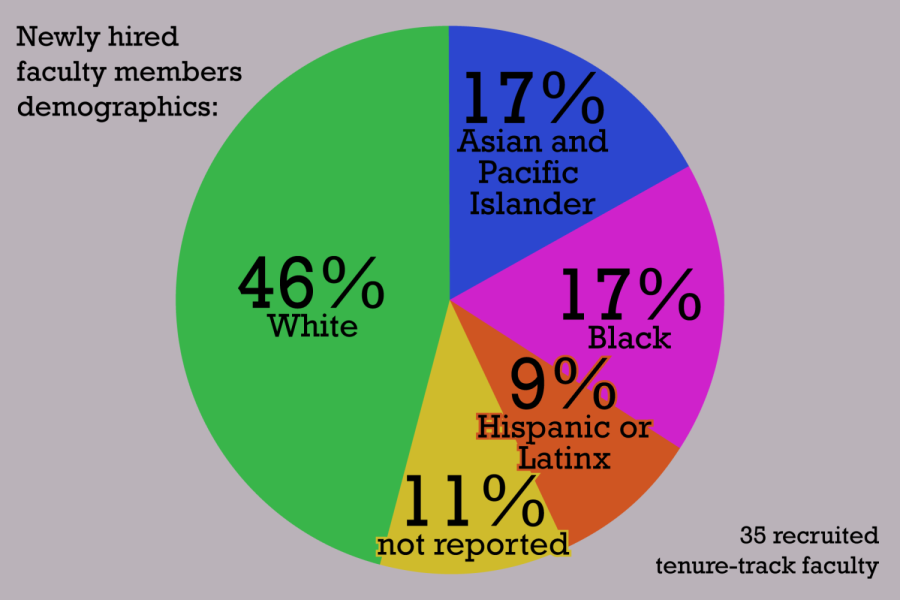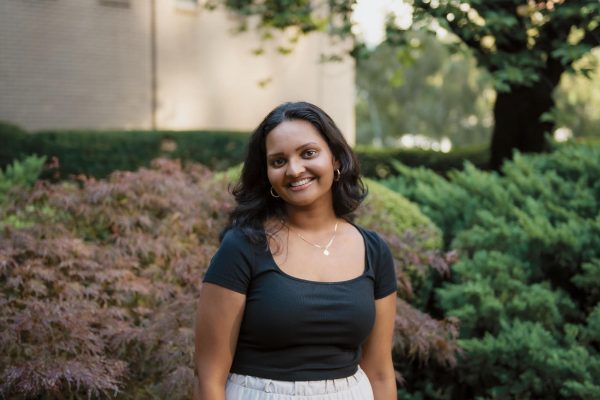Fordham Admin Outlines Initiatives to Improve Recruitment and Retention Among Diverse Faculty
Provost and Senior VP for Academic Affairs and Dean of Faculty of Arts and Sciences and Associate VP explain efforts to increase hiring and retention of diverse faculty
Fordham has made an effort over the past five years to increase the number of diverse faculty members.
January 30, 2022
What is now a seven-year effort, Fordham has made improvements over the last five years to diversify its higher administrative positions and improve retention rates among its staff identifying as Black, Indigenous, and People of Color (BIPOC).
At a press conference in November with The Fordham Observer and The Fordham Ram, Fordham University President Rev. Joseph M. McShane, S.J. underscored Fordham’s progress in improving recruitment and retention rates among diverse candidates. In comparison to other colleges and universities in New York, McShane noted the competition’s impact on the university’s ability to attract and retain diverse employees.
Dennis C. Jacobs, the provost and senior vice president for academic affairs, explained that efforts to increase hiring of diverse faculty were spearheaded in the fall of 2015 following McShane’s appointment of a Task Force on Diversity. The task force’s report, published in 2016, outlined 18 concrete recommendations. These recommendations included recruiting more BIPOC faculty and administrators, and designating a chief diversity officer.
Following the beginning of his tenure in January 2018, Rafael Zapata, the current chief diversity officer, collaborated with the human resources department and university leadership to review and update recruitment practices Zapata also serves on all hiring committees and established the Diversity, Equity and Inclusion (DEI) Council. The chief diversity officer also strives to improve diversity rates by conducting engaging faculty searches and providing training and support for search chairs and committees.
Eva Badowska, dean of the faculty of arts and sciences and associate vice president of arts and sciences, stressed that Zapata worked alongside departments within the Arts and Sciences to improve hiring practices and diversity rates. She also acknowledged that the resurgence of the Black Lives Matter movement in June 2020 ushered in a renewed sense of urgency for the university to focus on these efforts.
Badowska highlighted initiatives in Arts and Sciences departments to issue statements on combating anti-Black racism, examine biases within their curricula, and scrutinize past hiring practices.
“I cannot say that I have personally seen University’s promise to attain a more diverse faculty, being fulfilled.” Kennedy Robinson, FCLC ’22
Kennedy Robinson, Fordham College at Lincoln Center ’22 and an anthropology major and history minor, underscored that throughout her time at Fordham, the vast majority of her professors have been white.
“And in my two years at Fordham I have had approximately three classes with professors who are people of color,” she said. “So I cannot say that I have personally seen University’s promise to attain a more diverse faculty, being fulfilled.”
Robinson also believes that hiring diverse faculty significantly enhances and strengthens a student’s learning experience and that it is an invaluable and enriching advantage.
Due to financial constraints resulting from the COVID-19 pandemic, Fordham suspended virtually all planned faculty searches, according to Jacobs. Despite these challenges, the university still managed to hire new faculty members and welcomed 35 of them to the tenure-track.

“Looking back to fall 2020, the last cycle for which Fordham welcomed a full cohort (of) newly hired faculty members, the demographics of (the) 35 recruited tenure-track faculty were 46% white, 17% Black, 17% Asian and Pacific Islander, 9% Hispanic or Latinx, and 11% not reported,” Jacobs said.
Only 4-6% of Fordham’s tenure-stream faculty retire or depart from the university annually, Jacob added.
“It will require a sustained effort of recruiting diverse cohorts, such as the one described above, for Fordham to employ a faculty that reflects the diversity of all qualified faculty candidates and is more representative of Fordham’s student body,” he said.
The university’s spring 2021 racial breakdown of enrolled undergraduate and graduate students is 51.3% white, 7.9% Black, 9.6% Asian, 0.1% Native Hawaiian or Pacific Islander, 16.7% Hispanic or Latinx, 3.5% two or more races, and 1.8% unknown.
“Fordham has adopted a set of best practices to build strong, diverse pools of candidates each time we search to appoint a new administrator.”Dennis Jacobs, provost and senior vice president for academic affairs
The most diverse sectors of the university’s workforce in spring 2021 are the IT department (58% BIPOC) and the Office of Finance (52% BIPOC), in addition to maintenance and secretarial divisions. Jacobs explained that attempts to diversify professors and administrators are progressing through Fordham’s investment in building relationships with organizations that focus on promoting women and BIPOC scholars. These organizations include the Society for the Advancement of Chicanos and Native Americans in Science (SACNAS), the Association of Black Sociologists, and the Ph.D. Project.
“Fordham has adopted a set of best practices to build strong, diverse pools of candidates each time we search to appoint a new administrator,” he said. “When an academic dean steps down from their position, Fordham conducts a national search to identify their successor.”
Jacobs cited the recruitment of the late Tyler Stovall in fall 2020, the former dean of the graduate school of arts and sciences, and José Luis Alvarado in fall 2021, the dean of the graduate school of education, as examples of selecting diverse upper administrative candidates.
In regard to efforts afoot to ensure improved retention rates among faculty and administrators of diverse backgrounds, Badowska listed the deans’ creation of an Arts and Sciences deans’ advisory committee on anti-racism and anti-racism training and workshops for faculty and staff.
“We have also been working with departments and programs to build a community that is more supportive to faculty and administrators of color,” Badowska said. “For example, our office has collaborated with the department of African and African-American studies to launch a new program of Affiliated Faculty to create research and teaching network across departments and programs for faculty whose interests center on anti-racist studies, pedagogies and practices.”
Badowska emphasized efforts to ensure that methods of evaluation for tenuring faculty were bias-free, with departments reevaluating norms for tenure and promotion. The Faculty Evaluation Committee of the Arts and Sciences Council also conducted a two-year study on student course evaluations, which are a prominent technique of gauging a professor’s effectiveness and are important for adjuncts being considered for tenure.
“Expanding the pipeline of future faculty of color requires that universities provide opportunities for promising young scholars to flourish and develop a strong portfolio before they apply for a faculty position.” Dennis Jacobs
In response to the creation of anti-bias hiring initiatives, Badowska hopes that BIPOC faculty will be more willing to establish careers at Fordham, subsequently increasing the university’s capacity to recruit and retain diverse faculty.
Jacobs stressed that enlisting diverse faculty members stems from university endeavors to present students with an opening to showcase their expertise.
“Expanding the pipeline of future faculty of color requires that universities provide opportunities for promising young scholars to flourish and develop a strong portfolio before they apply for a faculty position,” he said.
Badowska also outlined several initiatives adopted by different departments to create more inclusive programs. Examples include the African and African-American studies department, which selects 8-12 outstanding students from the previous semester to deliver a presentation on their final papers, and the economics department, in which scholar Derrick Hamilton delivered a lecture titled “A Moral Responsibility for Economists: Anti-Racist Policy Regimes that Neuter White Supremacy and Establish Economic Security for All,” for the second distinguished economics lecture series.
“Being exposed to different ones who themselves have a myriad of different experiences could serve my discipline well.” Kennedy Robinson
Other departments in the Arts and Sciences whose DEI efforts Badowska praised were art history and music, comparative literature, communication and media studies, and English.
Robinson said the nature of being an anthropology major and history minor is that she often examines different cultures and lived experiences through her curricula. She asserted that professors from diverse backgrounds would give way to more perspectives and attitudes.
“I personally believe that as an Anthropology major and History minor taking classes that are so focused on exploring and understanding the human experience, being exposed to different ones who themselves have a myriad of different experiences could serve my discipline well,” she said.
Overall, Robinson believes that Fordham still has strides to make in terms of improving recruitment and retainment of diverse faculty.














